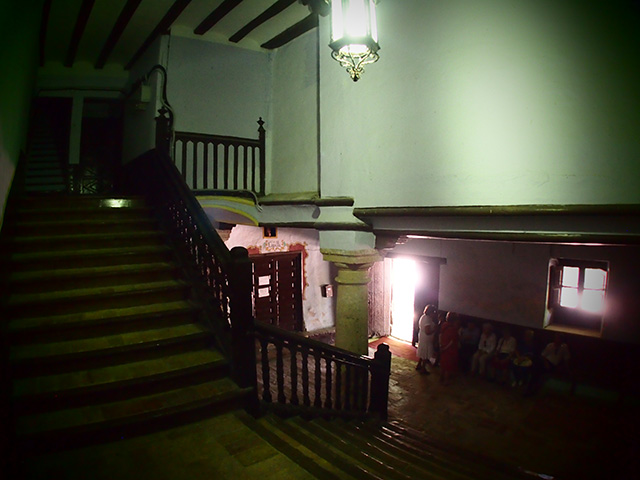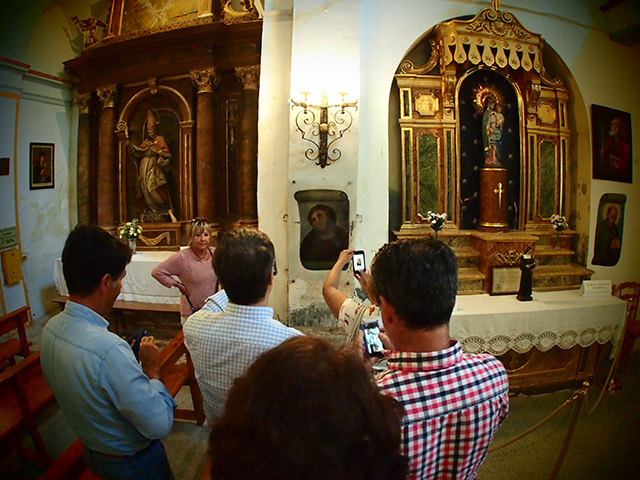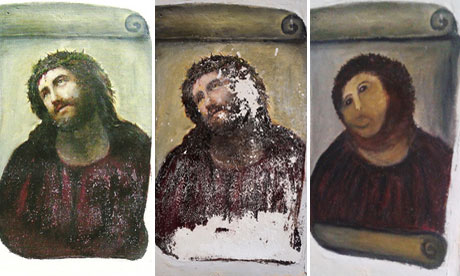‘Ecce Homo’ (Behold the Man) by Elías García Martínez, famously restored by 80 year old Cecilia Giménez, is the only work protected by glass in the chapel of Santuario de Misericordia, in a tiny village outside Borja, Spain.
The fresco, dubbed the ‘worst restoration in history’, has spawned one of the most popular memes of the past year, hilariously incorporating images of everything from the Titanic movie, ET, The Mona Lisa and The Scream, to Jonah Hill and Tom Jones, among others. It has been visited by millions of people around the world, yet the only indication of what awaits inside the humble chapel of Santuario de Misericordia is a small printed notice referring to the work and the restoration by Cecilia Giménez, posted in the pretty but nondescript square outside the church.Villagers are said to be delighted with the noteriety the fresco has brought to their village. The church has raised thousands of euros by charging a single euro entry fee and according to the Guardian, ‘some fortune-seeking Spaniards who have bought tickets for the country’s famous Christmas lottery, El Gordo or The Fat One, hope that Gímenez’s magic will rub off on them too. They have already snapped up all tickets bearing the numbers that match the date on which the Ecce Homo restoration was revealed to the world this August: 21812.’
On the day we visited, there was a line up of people waiting to see the fresco – all Spanish, interestingly – including a bus group of elderly women giggling and clutching rosaries (pictured below). Each of us paid one euro to see and take pictures with the unique art work, with the money donated to a local hospital.
As the Sydney Morning Herald recently explained, ‘The council started charging an entrance fee of €1, giving the money to the Sancti Spiritus charitable foundation, which used the windfall to help pay bills at a care home for 60 elderly people. The council also got lawyers to establish copyright and draw up a merchandising agreement that will see the image put on plates, postcards and cigarette lighters, among other items.”It’s a timely agreement,” said Councillor Ojeda. “The money is going to good causes.”
I couldn’t make this stuff up.
Awful restoration or small town miracle? History will be the judge.



* Photographs copyright of Tara Moss & Berndt Sellheim, 2013.
Below, photos of how the original looked, how the damaged fresco appeared and the current ‘restoration’ by Cecilia Giménez, care of The Guardian.






The lesson is either succeed fabulously, or fail spectacularly. Mediocrity is death in art 🙂
Oh c’mon! I can’t stop laughing!!!
I’m atheist so, yes, I can.
This woman saw the creation of her christ in her head and god
willing she put it on the wall…for all to admire…ahem.
She be the good disciple. LOL
Has Ecce Homo become Ecce Mono? The original Elias Garcia Martinez fresco was painted as an act of devotion in 1930 and has since suffered the depredations of time; something we have come to accept with aging works of art, especially of a religious nature. Indeed the restoration of Michelangelo’s Sistine Chapel ceiling drew howls of protest from art historians, many of whom who saw the removal of the patina of age as somehow unnatural. Perhaps the actions of Gimenez were perpetrated in the same spirit as those restorers who sought to bring the artist’s original colours and therefore intentions to the modern world. Whatever Gimenez’ motivation it has become lost, subsumed in the resulting internet sensation and twenty-first century ‘veneration’ by a flood of tourists, necessitating the placing of protective glass over this latter-day Mona Lisa. It’s as if the previously ignored image has now become something to be consumed. The event has also spawned a spoof Facebook page for the original artist Elías García Martínez, who is the latest in a long line of post mortem internet ‘celebrities.’ Whether restoration or vandalism, Gimenez’ work has perhaps been covered with a sheet of glass to protect it from the depredations of that other semi-skilled artist, the spray-can wielding graffiti-ist. But that sheet of glass is also somehow symbolic of how a more meaningful interrogation of Gimenez’ action has been postponed, until such time as we have been sufficiently removed from the media and other hype to see it more clearly.
Am really enjoying the blogs of your Spanish trip and also the high calibre of the photography accompanying the stories.
This is awful art work. It looks as though it is a woman with a muff around her head. How dare she desimate this picture of Christ like this.